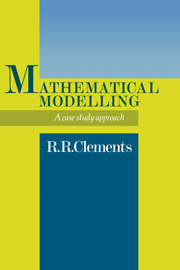3 - Mathematical modelling in practice
Published online by Cambridge University Press: 05 February 2012
Summary
This chapter attempts to identify and illustrate some of the practical skills needed by an effective mathematical modeller. It does this partly by direct comment on the modelling process and partly through the medium of a number of examples of the development of simple mathematical models. It should be apparent that no description of the processes of mathematical modelling can ever hope to be absolutely complete or to encapsulate the ‘last word’ on the subject. In that spirit then, this chapter draws on experience accumulated over a number of years by the author both in his capacity as a mathematician working in an engineering environment using his mathematical knowledge in the solution of engineering problems and in his capacity as a teacher of mathematics and mathematical modelling.
Understanding the problem
The first general comment to be made is that very little progress can be made in modelling if the modeller does not fully understand the system or situation which he or she is trying to model. (Before going any further let us, for the sake of brevity and clarity, acknowledge that the subject of a mathematical study may be any of a wide spectrum of entities ranging from concrete physical mechanisms through to relatively abstract systems of human activities and therefore agree to denote all of these possibilities by the single term ‘subject’.) The first stage of modelling should be the collection of data or experience about the subject to be modelled.
- Type
- Chapter
- Information
- Mathematical ModellingA Case Study Approach, pp. 24 - 40Publisher: Cambridge University PressPrint publication year: 1989
- 2
- Cited by



